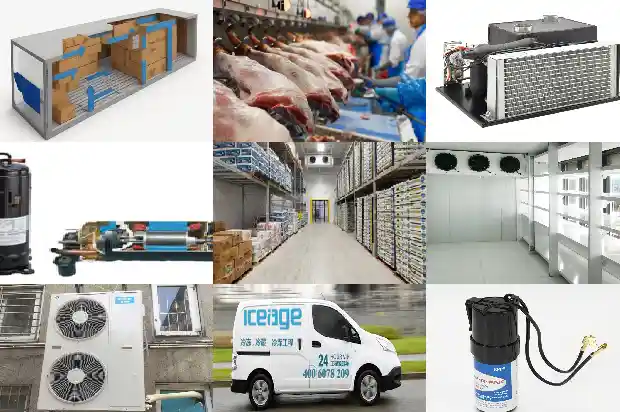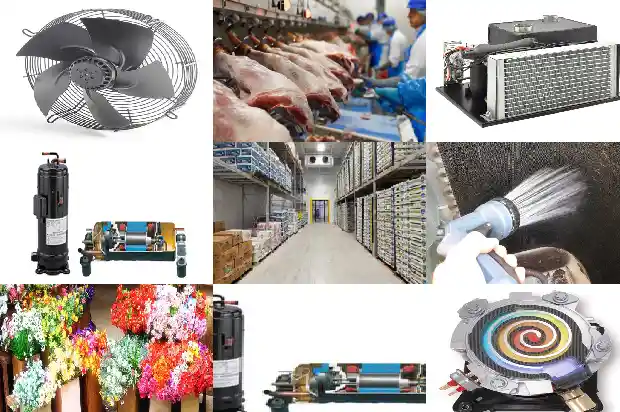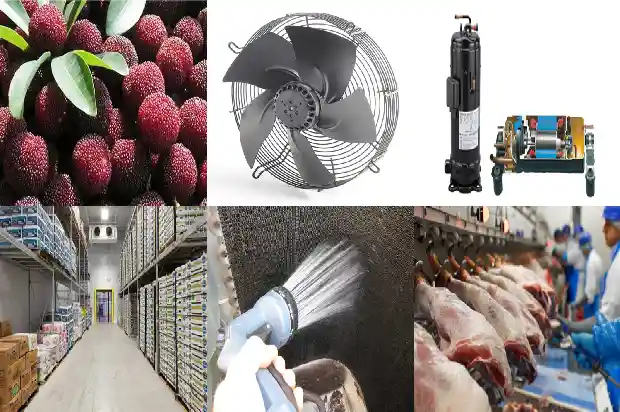Composition and Common Faults of Screw Refrigeration Compressors
2025-02-16
Screw refrigeration compressors belong to the positive - displacement type compressors, which compress gases through volume changes. The compressor utilizes two meshing and rotating screws with helical grooves placed inside the body, along with their cooperation with the inner wall of the body and the inner walls of the suction and discharge end seats, to create changes in the inter - tooth volume, thus completing the processes of gas suction, compression, and discharge.

Screw units include:
Screw refrigeration compressors; pipeline systems; oil systems; and control systems. These devices (except the starting cabinet) are installed on the same common base to form the unit.
Screw refrigeration compressors; pipeline systems; oil systems; and control systems. These devices (except the starting cabinet) are installed on the same common base to form the unit.
The gas - circuit system includes: suction stop valve, suction filter valve, suction check valve, discharge check valve, discharge stop valve, etc.
The oil - circuit system includes: high - efficiency oil separator, oil cooler, coarse oil filter, oil pump, fine oil filter, constant - pressure valve, oil return filter, etc.

Inside the body of the screw refrigeration compressor, two parallel rotors, a male rotor and a female rotor, are installed and meshed with each other. Below the male and female rotors, an energy - regulating slide valve driven by an oil piston in the oil cylinder is installed. Controlled by an electromagnetic (or manual) reversing valve, it can achieve stepless adjustment of the cooling capacity within the range of 10% - 100%.

Since the screw has good rigidity and strength, and there are no valves at the suction and discharge ports, when a small amount of liquid refrigerant passes through, "liquid hammer" will not occur. However, if a large amount of liquid is inhaled, "liquid hammer" will occur, accompanied by a loud abnormal noise.
Oil - circuit System
The oil - circuit system includes: high - efficiency oil separator, oil cooler, oil pump, coarse oil filter, fine oil filter, valves, etc. Lubricating oil plays the roles of lubrication, cooling, sealing, and noise reduction in the machine.
The oil - circuit system includes: high - efficiency oil separator, oil cooler, oil pump, coarse oil filter, fine oil filter, valves, etc. Lubricating oil plays the roles of lubrication, cooling, sealing, and noise reduction in the machine.
Oil Separator
The oil separator separates the lubricating oil entrained in the compressor's exhaust gas, making the high - pressure gas refrigerant entering the condenser pure, reducing the adverse effect of the lubricating oil film on heat transfer, and reducing the consumption of lubricating oil. At the same time, it creates the necessary oil - level difference to ensure the normal operation of the oil cooler.
The oil separator separates the lubricating oil entrained in the compressor's exhaust gas, making the high - pressure gas refrigerant entering the condenser pure, reducing the adverse effect of the lubricating oil film on heat transfer, and reducing the consumption of lubricating oil. At the same time, it creates the necessary oil - level difference to ensure the normal operation of the oil cooler.
Oil Cooler
The lubricating oil separated by the oil separator is in a relatively high - temperature state and cannot be directly sprayed into the compressor to play the roles of cooling and lubrication. The function of the oil cooler is to cool down this lubricating oil for recycling.
The lubricating oil separated by the oil separator is in a relatively high - temperature state and cannot be directly sprayed into the compressor to play the roles of cooling and lubrication. The function of the oil cooler is to cool down this lubricating oil for recycling.
Coarse Oil Filter
The coarse oil filter removes larger - sized impurity particles in the lubricating oil, cleans the incoming lubricating oil, and at the same time reduces the burden on the fine oil filter to ensure good lubrication and normal operation of the oil pump and compressor, and avoid wear. The filter element is a cylindrical structure made of stainless - steel wire mesh, and the end cover can be removed for replacing and cleaning the filter element. The filter element should be cleaned regularly. When cleaning, the filter element can be blown with compressed air to make the attached impurity particles fall off, then immersed in kerosene for cleaning, and finally blown clean with compressed air.
The coarse oil filter removes larger - sized impurity particles in the lubricating oil, cleans the incoming lubricating oil, and at the same time reduces the burden on the fine oil filter to ensure good lubrication and normal operation of the oil pump and compressor, and avoid wear. The filter element is a cylindrical structure made of stainless - steel wire mesh, and the end cover can be removed for replacing and cleaning the filter element. The filter element should be cleaned regularly. When cleaning, the filter element can be blown with compressed air to make the attached impurity particles fall off, then immersed in kerosene for cleaning, and finally blown clean with compressed air.
Fine Oil Filter
The fine oil filter further removes small - sized impurity particles in the lubricating oil to finally ensure that the lubricating oil entering the compressor is very clean, to ensure good lubrication and normal operation of the compressor bearings, rotors, shaft seals, etc., and reduce wear. It is similar to the coarse oil filter, but the stainless - steel wire mesh forming the filter element is denser. The filter element should be cleaned regularly, and the replacement work should be carried out when the machine is stopped.
The fine oil filter further removes small - sized impurity particles in the lubricating oil to finally ensure that the lubricating oil entering the compressor is very clean, to ensure good lubrication and normal operation of the compressor bearings, rotors, shaft seals, etc., and reduce wear. It is similar to the coarse oil filter, but the stainless - steel wire mesh forming the filter element is denser. The filter element should be cleaned regularly, and the replacement work should be carried out when the machine is stopped.
Under normal working conditions, the oil temperature is 60 - 70 °C. During operation, if there is excessive noise and the pointer of the oil - pressure gauge jitters or swings too much, it is necessary to check whether the coarse oil filter is blocked and whether there is gas in the oil - suction pipeline. If the above situations occur, they should be eliminated in a timely manner.
Oil Flow Switch
In a compressor system with an external oil separator, an oil flow switch should be installed to prevent the compressor from running out of oil.
In a compressor system with an external oil separator, an oil flow switch should be installed to prevent the compressor from running out of oil.
Economizer
Based on a general screw refrigeration compressor unit, an economizer is added. Although a general screw refrigeration compressor can operate normally under low - temperature working conditions, its economy is poor. By sub - cooling the high - temperature and high - pressure liquid from the liquid receiver in the economizer, the refrigeration capacity is increased, the coefficient of performance is improved, and the discharge temperature is reduced.
Based on a general screw refrigeration compressor unit, an economizer is added. Although a general screw refrigeration compressor can operate normally under low - temperature working conditions, its economy is poor. By sub - cooling the high - temperature and high - pressure liquid from the liquid receiver in the economizer, the refrigeration capacity is increased, the coefficient of performance is improved, and the discharge temperature is reduced.
Oil Differential Pressure Switch
The oil differential pressure switch detects the pressure drop before and after the oil - filter screen.
The oil differential pressure switch detects the pressure drop before and after the oil - filter screen.

Related Articles
- Basic Faults and Preventive Maintenance of Water - cooled Units
- Common Faults and Solutions of Central Air - conditioning Chiller Units
- Common Faults of Industrial Chillers
- Common Faults and Corresponding Solutions of Chillers During Use
- Analysis and Troubleshooting of Common Faults in Air - source Heat Pumps
- Maintenance Methods for Faults in Screw Refrigeration Air - conditioner Compressors
- Common Faults and Troubleshooting Methods of the Moving Mechanism of Piston Compressors
- Analysis of Common Faults in Compressor Overcurrent and Burnout
- What are the reasons for the inactivity of the automotive air conditioning compressor? What are the common faults?
- Common Faults of HVAC Fan Coil Units
- Common Operating Faults and Treatment Methods of Centrifugal Compressors
- Common Four Faults and Replacement Methods of Scroll Compressor
- Analysis of Refrigeration Compressor Motor Faults
- Analysis and Treatment of Common Low-Pressure Faults in Chillers
- Analysis and Treatment of Common Low Pressure Faults in Chillers
- Common faults in refrigeration system (discharge temperature and pressure)
- Common Faults of Screw Compressor
- Precautions for Commissioning of Screw Parallel Units
